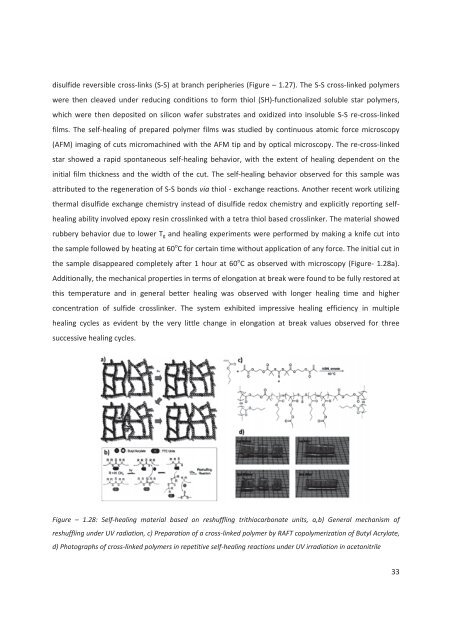4(%3)3 - Ecole nationale supérieure de chimie de Montpellier
4(%3)3 - Ecole nationale supérieure de chimie de Montpellier
4(%3)3 - Ecole nationale supérieure de chimie de Montpellier
Create successful ePaper yourself
Turn your PDF publications into a flip-book with our unique Google optimized e-Paper software.
disulfi<strong>de</strong> reversible cross-links (S-S) at branch peripheries (Figure – 1.27). The S-S cross-linked polymerswere then cleaved un<strong>de</strong>r reducing conditions to form thiol (SH)-functionalized soluble star polymers,which were then <strong>de</strong>posited on silicon wafer substrates and oxidized into insoluble S-S re-cross-linkedfilms. The self-healing of prepared polymer films was studied by continuous atomic force microscopy(AFM) imaging of cuts micromachined with the AFM tip and by optical microscopy. The re-cross-linkedstar showed a rapid spontaneous self-healing behavior, with the extent of healing <strong>de</strong>pen<strong>de</strong>nt on theinitial film thickness and the width of the cut. The self-healing behavior observed for this sample wasattributed to the regeneration of S-S bonds via thiol - exchange reactions. Another recent work utilizingthermal disulfi<strong>de</strong> exchange chemistry instead of disulfi<strong>de</strong> redox chemistry and explicitly reporting selfhealingability involved epoxy resin crosslinked with a tetra thiol based crosslinker. The material showedrubbery behavior due to lower T g and healing experiments were performed by making a knife cut intothe sample followed by heating at 60 o C for certain time without application of any force. The initial cut inthe sample disappeared completely after 1 hour at 60 o C as observed with microscopy (Figure- 1.28a).Additionally, the mechanical properties in terms of elongation at break were found to be fully restored atthis temperature and in general better healing was observed with longer healing time and higherconcentration of sulfi<strong>de</strong> crosslinker. The system exhibited impressive healing efficiency in multiplehealing cycles as evi<strong>de</strong>nt by the very little change in elongation at break values observed for threesuccessive healing cycles.Figure – 1.28: Self-healing material based on reshuffling trithiocarbonate units, a,b) General mechanism ofreshuffling un<strong>de</strong>r UV radiation, c) Preparation of a cross-linked polymer by RAFT copolymerization of Butyl Acrylate,d) Photographs of cross-linked polymers in repetitive self-healing reactions un<strong>de</strong>r UV irradiation in acetonitrile33











